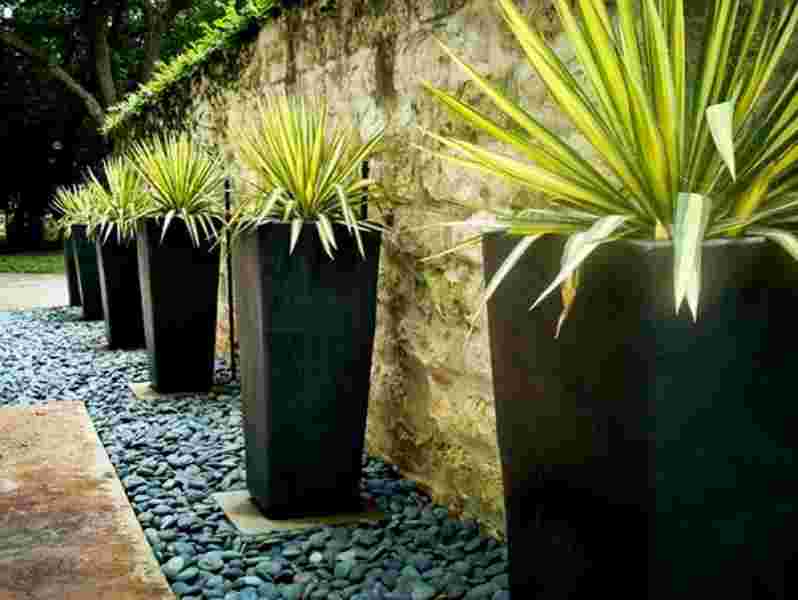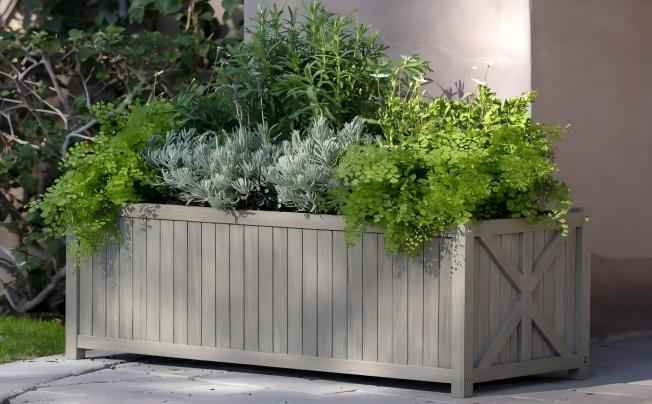What Type Of Flower Pots Are Best For Outdoor Plants?
Choosing the right material for your flower pots plays a key role in the growth of outdoor plants.
Suitable flower pots for different plants
1. Succulent plants: Succulent plants like a dry, breathable environment and typically have shallow roots. For this reason, shallow clay pots or other pots with strong air permeability are perfect for them. To avoid water buildup at the roots and decay, this type of pot can swiftly evaporate extra water. In addition, the shallow pot's dimensions match those of succulents' shallow root systems, which prevents waste of space and promotes improved root development and nutrient uptake.
2. Flower plants: Because flowers like roses and peonies grow more quickly and need more room to grow, it is better to use pots that are somewhat deep and wide, like medium-sized cement or ceramic pots. The dirt in these pots can be sufficient to provide flower roots enough room to spread out. Additionally, the durability of cement pots and the attractiveness of ceramic pots can both increase the overall viewing effect and match the beauty of flowers. Hanging pots are the ideal option for certain hanging flowers, such green radish and spider plants. This kind of pot lets flowers grow organically, creating a distinctive landscape and enhancing the outdoor area's aesthetic appeal.
3. Green plants: Big green plants, including Monstera and Pachira aquatica, need big, strong flower pots to support their rapid growth and well-developed root systems. Large metal or cement pots are a wonderful option right now. Metal pots are long-lasting and can prevent damage over time, whilst cement pots are sturdy and able to support the weight of green plants. Small clay pots or plastic pots are adequate for growing small green plants like asparagus fern and succulents. In addition to being easy to arrange, these little pots complement the beauty of tiny green plants and produce a cosy and charming ambiance.
The relationship between flowerpot size and plants
The development of outdoor plants is significantly influenced by the flowerpot's size.
If the flowerpot is too small, the plant's roots will not be able to spread out freely and there won't be enough room for new roots to grow. This will negatively impact the plant's ability to absorb water and nutrients, which will cause branches and leaves to grow slowly or even stagnate, significantly lowering the plant's ornamental value and flowering potential.
The plant will also have a lot of issues if the flowerpot is too big. The soil will stay wet for a long time and the air permeability will deteriorate if the flowerpot is too big because it will be difficult for the plant roots to absorb the water in the soil in time. This is comparable to persons residing in a room that is humid and inadequately aired, which increases the risk of illness. In such an environment, the roots of plants are also vulnerable to hypoxia, which can lead to illnesses like root rot and, in extreme situations, plant death.
Consequently, it is essential to make a sensible decision regarding the flowerpot's size depending on the plant's size, type, and root development. Large plants, like tall trees and flowers or perennial large green plants, require large flower pots with a diameter of more than 30 cm. Small plants, like succulents and small herbaceous flowers, are generally appropriate for small flower pots with a diameter of 10–20 cm. Medium-sized plants, like some common shrubs and flowers, are appropriate for medium-sized flower pots with a diameter of 20–30 cm. Concurrently, as the plants develop, the flower pots must be changed out with ones of the right size in order to accommodate the expanding root system of the plants.

Consider outdoor environmental factors
1. You should select flower pots that are light in colour and resistant to the sun if the outdoor light is intense. Dark flower pots have a tendency to absorb too much heat, which raises the temperature inside the pot and burns the roots of the plants. However, materials that can withstand the sun's rays are also crucial. Even after prolonged exposure to the sun, resin flower pots are resistant to deterioration and ageing.
2. Flower pots need to be sturdy and difficult to blow over in windy conditions. This criterion can be effectively addressed by large flower pots made of metal or cement that have a low centre of gravity and a wide bottom. They may nevertheless stay stable in high gusts and shield plants from harm because of their own weight and sturdy construction. In windy conditions, a flower container that is overly light—like some tiny plastic flower pots—can easily be blown off, harming or even killing the plants. Additionally, flower pots should have adequate drainage in places that receive a lot of rain to prevent water buildup from harming the roots of the plants. Flower pots made of clay or plastic that have several drainage holes at the bottom can efficiently remove extra water while preserving the soil's air permeability.
3. Because winter temperatures in frigid climates are low, flower pots must be somewhat resistant to frost. Clay flower pots are not appropriate for usage in cold climates since they are prone to breaking. Both metal and plastic flower pots are more resistant to frost and can shield plant roots during the chilly winter months. Select flower pots with enough heat dissipation in hot summer months to keep the interior temperature from rising too high. Because of their quick heat dissipation and good air permeability, clay flower pots can somewhat mitigate the negative effects of high temperatures on plants.
A balance between beauty and practicality
1. In terms of color matching, you can follow the principles of complementary colors, similar colors or the same color system. For example, in a garden dominated by green plants, some orange or yellow flower pots can be matched with the strong contrast of complementary colors to instantly attract the eye and add vitality and highlights to the garden; while choosing flower pots similar to the color of the plants, such as light green flower pots with light green succulents, can create a harmonious and soft atmosphere, making people feel comfortable and natural.
2. People prefer round flower pots because they feel soft and round, and they go well with plants that have round flowers, like hydrangeas, which work well together; square flower pots look simple and regular and are frequently used in modern courtyards because they echo the simple lines of furniture and buildings; irregularly shaped flower pots, like stone-shaped flower pots, can convey a more relaxed and natural atmosphere and blend in with the outdoor environment, making them ideal for planting some wild-style plants, like calamus, etc.
3. Metal flower pots with geometric textures are full of modern sense and can be paired with some unusual succulents or foliage plants to highlight fashion taste. Ceramic flower pots with delicate floral patterns are ideal for planting romantic flowers like roses, displaying an elegant temperament. Additionally, you can select flower pot designs based on the outside setting's theme. For instance, selecting flower pots with patterns of marine elements, like shells and starfish, might better complement the theme of a seaside-style courtyard.
4. The flower pot's practicality must be considered while maintaining its aesthetic appeal. The quantity and size of drainage holes should be suitable to allow water to be released in a timely manner, preventing water buildup and plant root rot. The flower pot's material should be strong and long-lasting, able to endure outdoor wind, sun, and climate change. In other words, we can only select the best flower pots for outdoor plants by striking a balance between aesthetics and functionality, which will make our outdoor area both lovely and vibrant.

Selected Blogs
-
What customization services are available for metalworking customization?
2024-12-12
-
What Is The Difference Between A Plant Container And A Raised Bed?
2024-04-23
-
Garden Screening & Fence Panels
2024-04-23
-
Gardening pot selection tips
2024-04-17
-
The function and collocation of horticultural fire pot
2024-04-17


